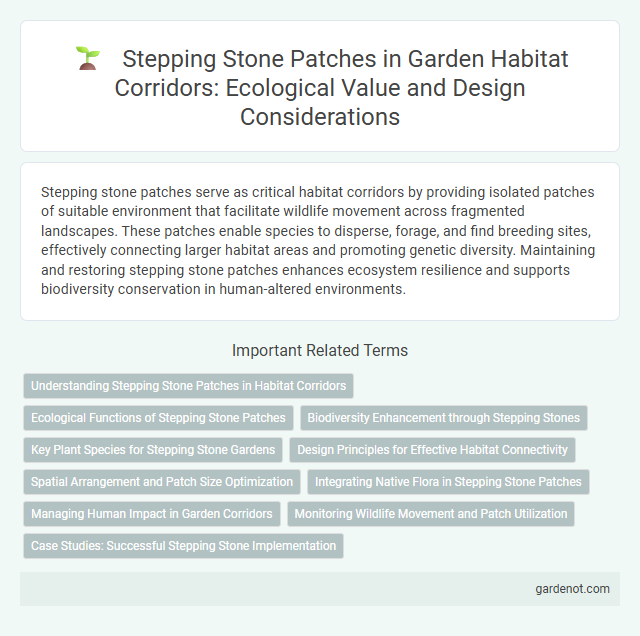Stepping stone patches serve as critical habitat corridors by providing isolated patches of suitable environment that facilitate wildlife movement across fragmented landscapes. These patches enable species to disperse, forage, and find breeding sites, effectively connecting larger habitat areas and promoting genetic diversity. Maintaining and restoring stepping stone patches enhances ecosystem resilience and supports biodiversity conservation in human-altered environments.
Understanding Stepping Stone Patches in Habitat Corridors
Stepping stone patches are small, strategically located habitat areas that facilitate wildlife movement between larger habitat corridors, enhancing landscape connectivity. These patches serve as crucial refuges and resources for species during migration or dispersal, reducing isolation and promoting genetic flow. Understanding the spatial arrangement and ecological characteristics of stepping stone patches is essential for effective conservation planning and maintaining biodiversity within fragmented landscapes.
Ecological Functions of Stepping Stone Patches
Stepping stone patches serve as crucial habitats that facilitate species movement across fragmented landscapes, enabling gene flow and population connectivity. These patches support vital ecological functions such as providing temporary shelter, foraging resources, and breeding sites for various wildlife, thus enhancing biodiversity resilience. By acting as intermediate habitats, stepping stone patches reduce habitat isolation and promote species dispersal in ecological networks.
Biodiversity Enhancement through Stepping Stones
Stepping stone patches serve as critical biodiversity enhancers by providing isolated habitats that facilitate species movement across fragmented landscapes. These small habitat patches increase genetic exchange and support diverse flora and fauna populations by connecting larger habitat corridors. Effective placement of stepping stones improves ecosystem resilience and promotes long-term conservation of threatened species.
Key Plant Species for Stepping Stone Gardens
Key plant species for stepping stone gardens in habitat corridors include native flowering plants like milkweed (Asclepias spp.), goldenrod (Solidago spp.), and coneflowers (Echinacea spp.) that provide essential nectar resources for pollinators. Shrubs such as Virginia sweetspire (Itea virginica) and spicebush (Lindera benzoin) offer fruit and shelter, enhancing habitat connectivity for birds and insects. Incorporating diverse native plants ensures continuous food and habitat supply, critical for wildlife movement across fragmented landscapes.
Design Principles for Effective Habitat Connectivity
Stepping stone patches are small, strategically placed habitat fragments that facilitate species movement across fragmented landscapes, enhancing habitat connectivity. Design principles emphasize patch size, quality, and spatial arrangement to maximize their function as intermediate refuges or resources for dispersing organisms. Ensuring these patches support target species' dispersal abilities and ecological requirements increases landscape permeability and genetic exchange.
Spatial Arrangement and Patch Size Optimization
Stepping stone patches serve as critical habitat corridors by facilitating species movement across fragmented landscapes, with their spatial arrangement directly influencing connectivity and gene flow. Optimizing patch size enhances habitat quality and resource availability, ensuring viable population support and reducing edge effects. Strategic placement and sizing of these patches maximize landscape permeability, promoting biodiversity conservation and ecosystem resilience.
Integrating Native Flora in Stepping Stone Patches
Stepping stone patches play a critical role in habitat corridors by facilitating species movement and genetic exchange between isolated populations. Integrating native flora in these patches enhances ecological connectivity, providing essential food and shelter resources tailored to local wildlife. Utilizing region-specific plant species supports biodiversity resilience and promotes long-term habitat sustainability within fragmented landscapes.
Managing Human Impact in Garden Corridors
Stepping stone patches in garden corridors serve as critical habitats for wildlife, enabling safe movement between larger green spaces while minimizing disruptions from urban development. Effective management of human impact includes controlling foot traffic through designated paths and limiting pesticide use to preserve native flora and fauna within these patches. Incorporating native plant species and creating buffer zones further enhance biodiversity and ecological connectivity in these urban habitats.
Monitoring Wildlife Movement and Patch Utilization
Stepping stone patches serve as critical nodes facilitating wildlife movement across fragmented habitats, enabling species to traverse between larger habitat areas. Monitoring these patches involves tracking species presence, movement patterns, and frequency of use through tools like camera traps, GPS collars, and genetic surveys to assess connectivity effectiveness. Data gathered informs habitat management strategies to enhance landscape permeability and biodiversity conservation.
Case Studies: Successful Stepping Stone Implementation
Successful stepping stone patch implementations in habitat corridors enhance species migration and genetic diversity, as demonstrated by case studies in the Banff National Park, Canada, where patches facilitated safe wildlife movement across the Trans-Canada Highway. In the Netherlands, the Oostvaardersplassen nature reserve uses strategically placed stepping stone patches to connect fragmented habitats, promoting bird and insect dispersal. Research from Australia's Great Barrier Reef island networks highlights that stepping stone patches improve marine species connectivity, aiding resilience against environmental changes.
Stepping stone patch Infographic

 gardenot.com
gardenot.com